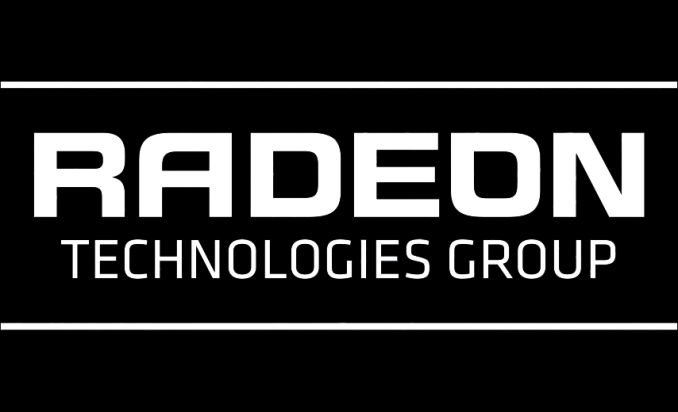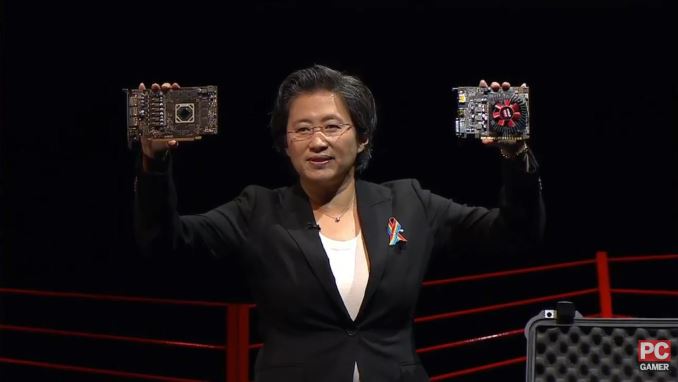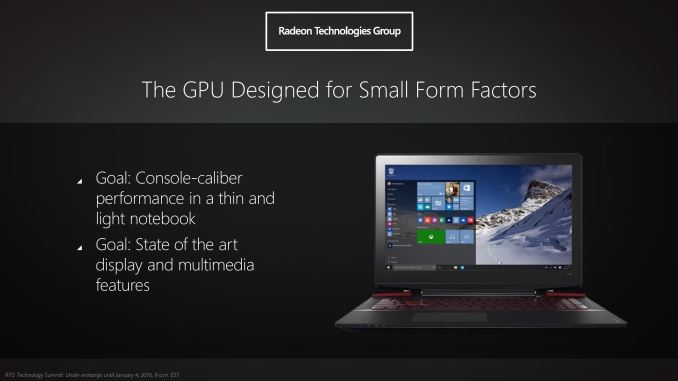AMD Teases Future Radeon RX 470 & Radeon RX 460 Cards
by Ryan Smith on June 13, 2016 3:30 PM EST
With the annual Electronic Entertainment Expo once again upon us, this week has been a flood of gaming hardware and software news. On the PC front, AMD is once again sponsoring PC Gamer’s PC Gaming Show, and while the company isn’t making quite as large of a presence this year – having just announced a bunch of tech at Computex – AMD is still attending E3 to tease a bit of hardware. Announced in a press release that’s going out at the same time as the PC Gaming Show starts, AMD is very briefly teasing the next two Polaris-based Radeon cards: the Radeon RX 470 and the Radeon RX 460.
AMD previously teased the Radeon RX 480 back at Computex, and with that card not shipping until the end of this month, the RX 470 and RX 460 are even more brief teases, essentially amounting to AMD confirming that they will exist.
As you can assume from the numbers, the RX 470 and RX 460 will slot in below the $199 RX 480. AMD’s press release specifically notes that the RX 470 is a “refined, power-efficient HD gaming” card. Whereas the RX 460 is a “a cool and efficient solution for the ultimate e-sports gaming experience.” These are no further details such as performance, specifications, or pricing, so this is a true teaser in every sense of the word.
Based on their admittedly short descriptions, it sounds like the RX 470 and RX 460 will slot in to very similar positions as the R7 370 and R7 360 respectively, as these are the same markets AMD pitched those cards at. This would make the RX 470 a budget 1080p card, while RX 460 is pitched specifically at MOBA players and the like, as those games have relatively low system requirements. Lower-end cards of this nature have also proven very popular in China, where MOBAs are especially popular and the pricing is better aligned with what most consumers can afford.
For what it’s worth, those cards launched at $149 and $109 respectively, so that may give us a ballpark idea of what to expect. Note that AMD only has two Polaris chips – the larger Polaris 10 and the smaller Polaris 11 – so it’s not clear how AMD may split these up. Historically, Radeon x60 cards have been based on chips that have been prevalent in smaller, mid-performance laptops.
On that note there’s one last passage from AMD’s press release I want to point out. In reiterating their talking point about bringing “console-like” performance to thin and light laptops, AMD’s release mentions that Polaris offers “exceptionally low power and low-z height.” Like everything else, no further details are provided, but I don’t suspect this is the last we’ve heard of this point. Having seen a very early Polaris 11 last December it’s definitely a small chip, and it sounds like AMD focused not just on package size, but thickness as well. Z-height is not something I’ve previously paid attention to, so I’m not immediately sure how thick AMD’s last-generation chips were, or whether this has been much of a problem on a competitive basis.












105 Comments
View All Comments
TheinsanegamerN - Monday, June 13, 2016 - link
AMD's flagship is vega, not polaris. Polaris has always been mid range.wiak - Monday, June 13, 2016 - link
then you have never heard of yields?, amd can make twice as many dies on a wafer compared to nvidia, and you probably havnt notice the crappy FE pricing and all the pricing mess with the latest 1000 series cards have you?the Funders Edition cards are just renamed inferior reference cards that sells at a premium
silverblue - Tuesday, June 14, 2016 - link
Anything can happen from one generation to the next, though it's usually a gradual swing in fortunes rather than a complete blitzing. I think one of the reasons that the GTX 750 (and Ti) did so well was because of its power requirements (or lack thereof); with the spectre of "bad drivers" starting to leave AMD (and it's far overdue), having a much more frugal 1080p offering will mean that people who went for NVIDIA last time over power and drivers might not be so eager to remain in the green camp, especially if - as is par for the course - AMD charges less.Until the cards are released and we get sales figures (or Steam figures, if that's what you prefer), I don't think we can say for sure what will sell the most and by how, let alone what is going to perform better.
fanofanand - Tuesday, June 14, 2016 - link
Being able to run the 750ti off the Pci-e was the primary reason for purchase for a LOT of people. Anyone who bought a pre-fabbed tower was able to slot one in, which opened up a massive market. If AMD attacks that market, Nvidia will lose one of it's many cash cows.ddriver - Monday, June 13, 2016 - link
he does as good as a troll canImSpartacus - Monday, June 13, 2016 - link
Wow, the halo effect is real.I'm amazed at how many people are seriously miffed at AMD's unique lineup in 2016.
You always hear about the halo effect, but it's definitely noticeable with people now.
Meteor2 - Tuesday, June 14, 2016 - link
The funny thing is that while Nvidia has their halo products, they don't actually have the rest of their product line-up to have a halo effect upon. Neither a 1060 nor a 1050 have been even announced, have they?revanchrist - Monday, June 13, 2016 - link
RX 470 aka cutdown Polaris 10 has performance roughly equals to GTX 970, and it's only $150, which means basically everyone can afford it, even in their secondary and tertiary PC at home. While RX 480 tackles GTX 980 at $200-250. Most popular GPUs on Steam are GTX 970 and 960. And i seriously doubt a 1060 will be as strong as a 980, and i doubt even more that it will cost any lesser than $250, judging from the pricing of 1070 and 1080. You saw a bad future for AMD while i saw a bad one for Nvidia.MatthewShine - Monday, June 13, 2016 - link
I actually prefer Nvidia cards, but this is a smart move from AMD.Nvidia just released high end cards with rather large price tags, and as someone already mentioned, they don't sell as well as midrange cards.
Midrange cards take a HUGE amount of the market share, and AMD are getting in there before Nvidia can release their 1050/1060 models.
to;g - Monday, June 13, 2016 - link
why are so many people so fucking uninformed, Vgea is gonna be the one to rip the nuts off of pascal coming in October. and oh please, the 60 series is was and will always be the great shame of nvidia, got nothing on the 480.